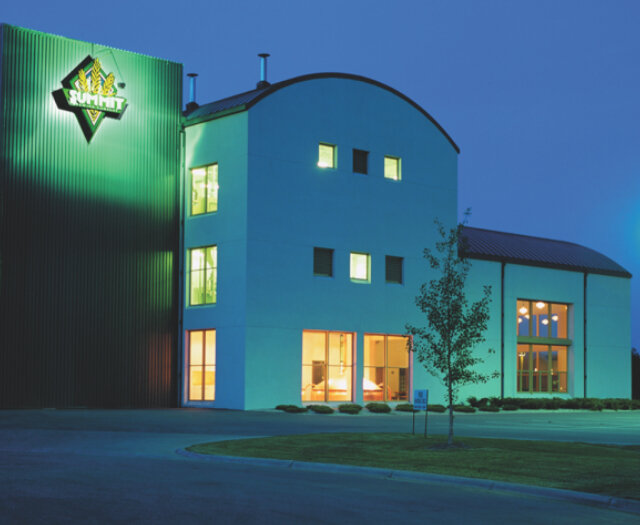
Market Watch
After conversations with noted industry insiders throughout the early 1980s, Stutrud began working full-time to get the brewery running. He researched what it would take to start and spent his vacation learning the craft. Stutrud and his wife Margaret committed their life savings to the venture, and Stutrud enrolled in Chicago's Siebel Institute of Technology in May 1984 to learn the brewing trade. He completed market research, business development, and got the financing to open a 6,000-barrel-per-year brewery during this period. Stutrud incorporated the Summit Brewing Company (Summit) in 1984.
Commercial production began in September 1986 out of a 7,500-square-foot, former auto parts store at 2264 W. University Avenue in St. Paul. The company's day-one focus was to sell underrepresented beer styles. Its first product line was an English-style pale ale called Extra Pale Ale and a porter named Great Northern Porter.
On September 24, the brewery sold its first two kegs to Johnny's Bar, located across the street. Initially, Summit struggled to find wholesalers to represent them. The company turned to restaurants and clubs that sold boutique wines, hoping they'd also consider boutique beers. The strategy worked, and within the first six months of business, Summit was self-distributing to fifty accounts.
Authenticity played a crucial role in the company's early success. Summit remained committed to its regional roots despite entering the market at a time when large breweries dominated the national landscape. In its first three years, production increased from 1,500 to 3,700 barrels. Besides the two flagships, the product line expanded to include seasonal brews. Over time, the company's growth necessitated expansion. In July 1993, Summit leased a building across the alley at 731 Hampden Avenue and converted it into a bottling house. The addition expanded brewing capacity from 15.000 to 25,000 barrels a year.
By 1995 Summit had grown to be the fifth-largest microbrewery in the United States. It had outgrown its current space and had begun considering other locations. Company executives felt existing Twin Cities structures were ill-suited for a brewery, and they looked for land to build a new brewery from the ground up.
On May 25, 1996, the St. Paul Port Authority announced it was considering selling 4.24 acres of undeveloped land at the Crosby Lake Business Park to Summit for one dollar. In exchange, the company committed to building a new million-dollar brewing facility that would allow them to increase yearly production capacity from twenty-seven thousand barrels to seventy thousand. Summit also agreed to hire at least ten additional employees.
The project, which took over three years to complete, more than doubled the company's brewing capacity. It began operation in October 1998. The new facility was the first new brewery built from the ground up in the state since before Prohibition.
In June 2013, the company expanded again, adding 7,632 square feet of cellar space with twelve 600-barrel fermentation vessels. This expansion increased their yearly production capacity to 240,000 barrels. They also opened a canning facility. The company, known as a bottle-only beer for years, soon began canning its beer.
Despite its size, Summit remained committed to great-tasting craft beer. It boasted multiple award-winning styles, and won on local, national, and international stages. Gone were the days of only the EPA and Great Northern Porter. Though they remained the company's flagship beers, they were joined by a continually growing line-up to entice beer drinkers with ever-discerning and ever-changing palates.
The industry also changed. Gone are the days when Summit was one of a few local beers in a world of national brands. The 2011 Surly Bill opened the doors to local craft beer market competition Summit hadn't before seen. In 1986 there were nine craft brewers nationwide. Today, according to recent numbers, there are hundreds in Minnesota alone.
An influx of new breweries - and taprooms - negatively impacted Summit's bottom line, but the company continued to grow. It even got into the taproom game, re-opening its expanded Ratskeller, once a place for community organizations and non-profit groups, to the public in July 2018. Summit beer has resonated with Minnesotans, and in 2020, while overall growth had slowed, it was named the largest brewery in the state by barrels produced annually.
From the new kid on the block to a best-seller, Summit has seen incredible growth in over thirty years. The company is now an "establishment" brewery recognized as the pinnacle of achievement by other local and hyper-local brewers. Stutrud, who has bristled at the idea of being labeled an "insider," encourages the competition - with a caveat. Ever customer-centric, he believes that as long as a hyper-focus on quality control remains top-of-mind, more local players brewing quality, sustainable beer can only benefit the consumer.
This work is licensed under Creative Commons BY-NC 4.0
Bibliography
- "The SUMMIT Interview with Mark Stutrud." BeerScribe. Last modified November 2004. https://www.beerscribe.com/stutrud.html.
- "April 14, 2015 PROGRAM: Changes in the Brewing Industry." Rotary Club of Saint Paul #10. Last modified April 13, 2015. https://stpaulrotary.org/Stories/april-14-2015-program-changes-in-the-brewing-industry.
- "Summit encourages competition to brew in Twin Cities." Pioneer Press, July 20, 2013. https://www.twincities.com/2013/07/20/summit-encourages-competition-to-brew-in-twin-cities/.
- "30 Years of Beer: A Summit Brewing Timeline." Growler Magazine. Last modified February 13, 2020. https://www.growlermag.com/30-years-of-beer-a-summit-brewing-timeline/.
- "How Mark Stutrud Started Summit Brewing Co." Minneapolis / St. Paul Business Journal. Last modified November 25, 2013. https://www.bizjournals.com/twincities/news/2013/11/22/how-mark-stutrud-started-summit.html.
- "Largest Breweries in Minnesota." Minneapolis / St. Paul Business Journal. Last modified June 24, 2021. https://www.bizjournals.com/twincities/subscriber-only/2021/06/24/largest-breweries-in-minnesota.html.
- "Our History." Summit Brewing Company. https://www.summitbrewing.com/about/history/.
- "Summit Of Success." Market Watch. Last modified October 31, 2017. https://www.marketwatchmag.com/summit-of-success/.